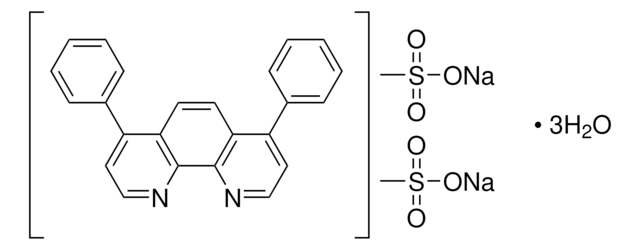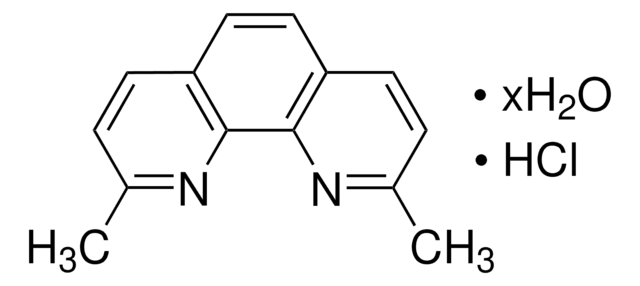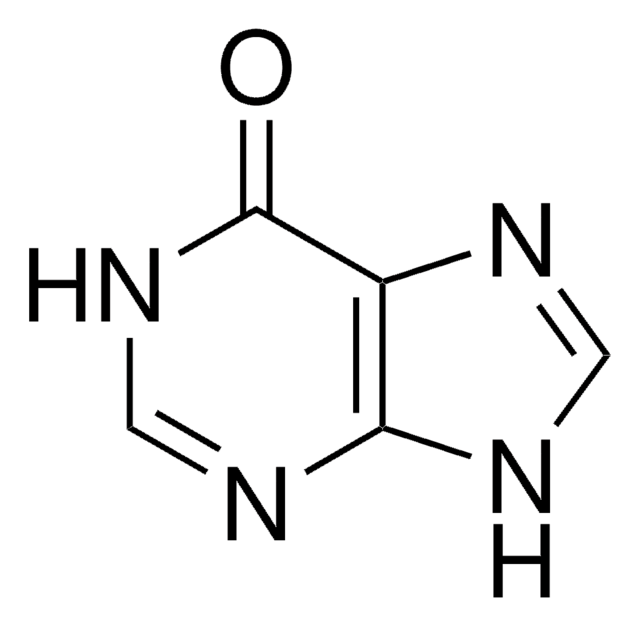B1125
Bathocuproinedisulfonic acid disodium salt
7.2-9.1% purity dry basis (ICP), powder
Synonym(s):
2,9-Dimethyl-4,7-diphenyl-1,10-phenantrolinedisulfonic acid disodium salt, Disodium bathocuproinedisulfonate
About This Item
Recommended Products
Product Name
Bathocuproinedisulfonic acid disodium salt, for spectrophotometric det. of Cu, Fe
Assay
7.2-9.1% dry basis (ICP)
form
powder
quality
for spectrophotometric det. of Cu, Fe
technique(s)
titration: 90% using HCLO4 (Dry Basis)
color
white to beige
solubility
H2O: 50 mg/mL
suitability
suitable for determination of copper
application(s)
diagnostic assay manufacturing
hematology
histology
storage temp.
room temp
SMILES string
[Na+].[Na+].[S](=O)(=O)([O-])c1c(nc2c3nc(c(c(c3ccc2c1c5ccccc5)c4ccccc4)[S](=O)(=O)[O-])C)C
InChI
1S/C26H20N2O6S2.2Na/c1-15-25(35(29,30)31)21(17-9-5-3-6-10-17)19-13-14-20-22(18-11-7-4-8-12-18)26(36(32,33)34)16(2)28-24(20)23(19)27-15;;/h3-14H,1-2H3,(H,29,30,31)(H,32,33,34);;/q;2*+1/p-2
InChI key
RNGKZLRAVYPLJC-UHFFFAOYSA-L
Looking for similar products? Visit Product Comparison Guide
General description
Application
- Bathocuproinedisulfonic acid disodium salt has been used as a copper chelator for specific assay in Arabidopsis seedlings.
- It has been used as an electron chain-associated free radical production inhibitor for superoxide dismutase assay in cells.
- It has been added to the culture media of trypanosomes as a copper chelator for the stabilization of cysteine.
Other Notes
Storage Class Code
11 - Combustible Solids
WGK
WGK 3
Flash Point(F)
Not applicable
Flash Point(C)
Not applicable
Personal Protective Equipment
Regulatory Listings
Regulatory Listings are mainly provided for chemical products. Only limited information can be provided here for non-chemical products. No entry means none of the components are listed. It is the user’s obligation to ensure the safe and legal use of the product.
ISHL Indicated Name
Substances Subject to be Indicated Names
ISHL Notified Names
Substances Subject to be Notified Names
JAN Code
B1125-25G:4548174008041
B1125-1G:4548174008034
B1125-100MG:
B1125-5G:4548174008065
B1125-VAR:
B1125-500MG:4548174008058
B1125-BULK:
Choose from one of the most recent versions:
Already Own This Product?
Find documentation for the products that you have recently purchased in the Document Library.
Customers Also Viewed
Our team of scientists has experience in all areas of research including Life Science, Material Science, Chemical Synthesis, Chromatography, Analytical and many others.
Contact Technical Service












